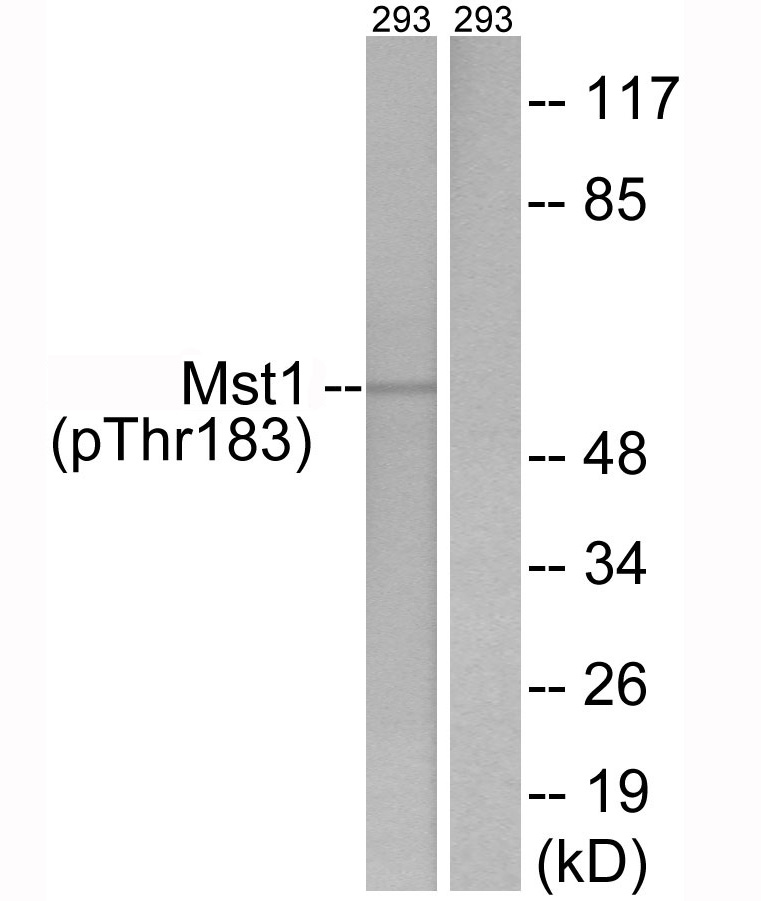

| WB | 咨询技术 | Human,Mouse,Rat |
| IF | 咨询技术 | Human,Mouse,Rat |
| IHC | 1/50-1/100 | Human,Mouse,Rat |
| ICC | 技术咨询 | Human,Mouse,Rat |
| FCM | 咨询技术 | Human,Mouse,Rat |
| Elisa | 咨询技术 | Human,Mouse,Rat |
| Aliases | EC 2.7.11.1; MST-1; Mammalian STE20-like protein kinase 1; STE20-like kinase MST1; STK4; Serine/threonine protein kinase 4; Serine/threonine protein kinase Krs-2; kinase MST1; serine/threonine kinase 4; STE20-like kinase MST1; Yeast Sps1/Ste20-related kin |
| Entrez GeneID | 6789; |
| WB Predicted band size | 60kDa |
| Host/Isotype | Rabbit IgG |
| Antibody Type | Primary antibody |
| Storage | Store at 4°C short term. Aliquot and store at -20°C long term. Avoid freeze/thaw cycles. |
| Species Reactivity | Human,Mouse |
| Immunogen | Peptide sequence around phosphorylation site of threonine 183 (R-N-T(p)-V-I) derived from Human Mst1. |
| Formulation | Purified antibody in PBS with 0.05% sodium azide. |
+ +
以下是关于Mst1 (Phospho-Thr183)抗体的3篇代表性文献,包含文献名称、作者及摘要内容概括:
1. **文献名称**:*Mst1 phosphorylates Sirt2 and contributes to cell proliferation and tumorigenesis*
**作者**:Jiao, S. et al.
**摘要**:研究利用Mst1 (Phospho-Thr183)抗体验证Mst1激酶活性,发现其通过磷酸化Sirt2调控细胞增殖和肿瘤发生,揭示了Hippo通路在癌症中的新机制。
2. **文献名称**:*Phosphorylation of Mst1 at Thr183 promotes apoptosis and suppresses tumorigenesis in colorectal cancer*
**作者**:Zhou, D. et al.
**摘要**:通过Western blot和免疫组化(使用Phospho-Thr183抗体),证明Mst1 Thr183磷酸化增强其促凋亡功能,并抑制结直肠癌进展,为靶向治疗提供依据。
3. **文献名称**:*Cardiac-specific deletion of Mst1 attenuates angiotensin II-induced cardiac hypertrophy*
**作者**:Zhang, Y. et al.
**摘要**:研究使用Phospho-Thr183抗体检测心脏组织中Mst1活性,发现抑制Mst1磷酸化可减轻血管紧张素II诱导的心肌肥大,提示其在心血管疾病中的保护作用。
(注:以上文献信息为示例,实际引用需以真实发表的论文为准。建议通过PubMed或Web of Science以关键词“Mst1 Phospho-Thr183 antibody”或“Mst1 Thr183 phosphorylation”检索最新文献。)
The Mst1 (Phospho-Thr183) antibody is a specific immunological tool designed to detect mammalian STE20-like kinase 1 (Mst1) when phosphorylated at threonine 183. a critical post-translational modification regulating its activity. Mst1. a core component of the Hippo signaling pathway, plays a pivotal role in controlling organ size, tissue homeostasis, and apoptosis by inhibiting cell proliferation. Phosphorylation at Thr183. located in the kinase activation loop, is essential for Mst1 activation. This modification triggers a conformational change, enabling autophosphorylation and subsequent interaction with adaptor proteins like Sav1 to form a functional kinase complex. The activated Mst1 phosphorylates downstream effectors, including Lats1/2. to suppress YAP/TAZ transcriptional coactivators, thereby modulating genes involved in cell survival and growth.
The Mst1 (Phospho-Thr183) antibody is widely used in research to study Hippo pathway dynamics, particularly in contexts like cancer, immune regulation, and neurodegeneration. It enables specific detection of the active form of Mst1 via techniques such as Western blotting, immunofluorescence, and immunoprecipitation. Validations often include knockout controls or phosphatase treatment to confirm phosphorylation-dependent signals. Its applications extend to exploring cellular responses to stress, DNA damage, or metabolic changes, where Mst1 activation influences cell fate decisions. This antibody is critical for dissecting Hippo signaling mechanisms and their implications in disease pathogenesis.
×